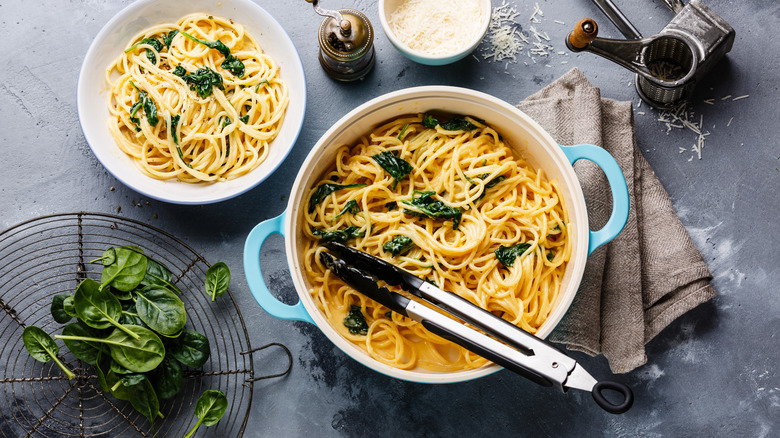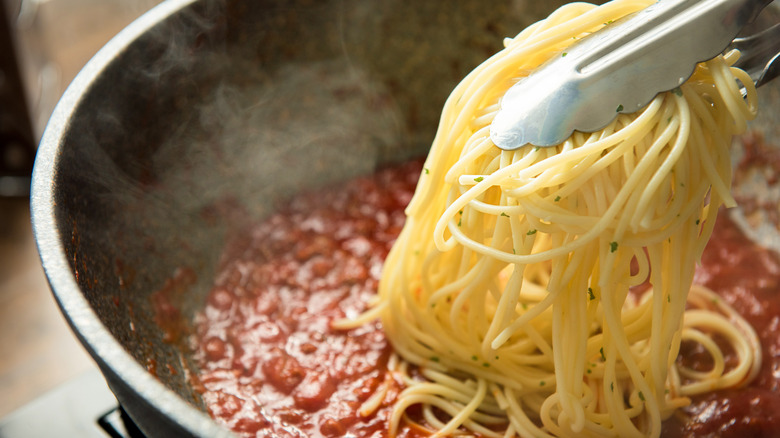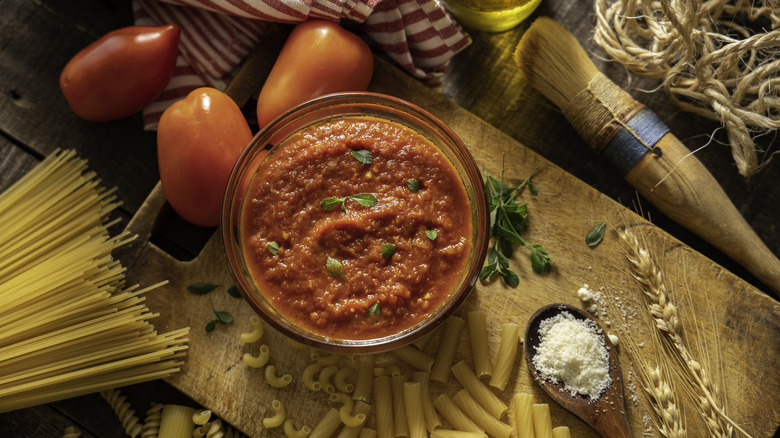There's A Right Way To Sauce Pasta And It's All About The Tongs
Nothing hits the spot after a long day like pasta. From classic bucatini cacio e pepe to spaghetti with a simple tomato sauce, a heaping plate of noodles slathered in sauce and dusted with parmesan is enough to make anyone's mouth water. It also helps that pasta is super easy to make — but what if you could use a tried-and-true method to take it from good to great, with minimal extra effort? For perfectly sauced pasta, it's time to turn to tongs.
As any aficionado of Italian cuisine knows, the last thing you want is a pile of pasta that's either underdressed or drowning in a big pool of sauce. Fortunately, both of these scenarios are easy to avoid. Tongs are useful for much more than flipping a sizzling steak — they're the easiest and most effective tool to use to transfer pasta from its cooking pot to a pan of sauce, then tossing the two together for the perfect marriage of flavors and textures. They also make long noodles much easier to serve, and they work for any sauce you can dream up, whether it be pesto, tomato, Alfredo, or Bolognese. Ready to test it out yourself? Here's how to wield your tongs like a pro.
How to toss pasta in sauce with tongs
Regardless of your recipe, the right technique for saucing pasta is fairly simple. While the pasta boils on the stove, any tomato or cream-based sauces should be simmering in a pot, so they're hot and ready for the noodles, while quick oil-based sauces can be made just before the pasta is done. If you plan to finish cooking your pasta in a pan, get ready to sauce it about a minute before the noodles are done boiling.
Scoop out some pasta water from the pot, in case your sauce needs thickening, then transfer the pasta into the neighboring pan with tongs. Some of the starchy water will cling to the strands and wind up in the sauce, which can help enrich it and bind it better to the pasta. Use your trusty tongs to toss the noodles around gently. Unlike stirring with a spoon, the tongs let you toss and swirl the pasta with ease, so each noodle is coated from end to end, in all its ridges and curves.
Saucing pasta on the stove, compared to spooning the sauce over a pile of noodles, makes it easy to avoid adding too much sauce per serving. And instead of struggling to dole out long noodles like spaghetti without splattering sauce everywhere, just clamp a portion of pasta with your tongs and plate it. With a little parmesan and fresh basil, you'll be ready to enjoy the perfect pasta dish.
How much sauce should you use for pasta?
It's important to note that if you're working with a small shape of pasta, like penne or macaroni, tongs might not grab them as well. Instead, a spider strainer can get the job done. Just use it similarly to toss the pasta and then easily scoop the noodles up to serve. No matter what shape you're using, though, you have to address the age-old question: How much sauce is too much?
While it would be convenient if there was a single rule to live by, the answer isn't so cut and dry. The ideal amount of sauce depends on which type of noodle you're using, but you can start off with a set amount and add more from there. According to the Italian company Barilla, the world's largest pasta producer, 24 ounces of tomato-based sauce is sufficient for a 16-ounce package of pasta. You don't need as much when it comes to rich, creamy sauces; 16 ounces or less will do. For oil-based sauces like pesto, go much lighter — about 6 ounces of sauce for the same amount of pasta.
Notably, authentic Italian pasta dishes tend to be light on the sauce, instead of the noodles swimming in it. Of course, if you prefer a heavily-drenched pasta, who's to tell your tastebuds they're wrong? At the end of the day, you can eat your pasta how you like it — sauced perfectly thanks to a trusty pair of tongs.


